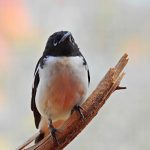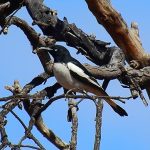PIED HONEYEATER
The Pied Honeyeater is a striking bird, predominantly black and white, which makes it stand out against the muted hues of its surroundings. The males are particularly eye-catching, with glossy black plumage contrasted by a white patch on their wings and a white belly. Females and juveniles are more subdued, with greyish-brown tones replacing the stark black of the males, yet they share the distinctive white wing patches.
This bird is a true wanderer of the Australian interior, found across the arid and semi-arid zones of the continent. It favours open woodlands, shrublands, and areas where Acacia and Eremophila plants are abundant. These habitats provide not only food but also nesting sites and shelter.
The Pied Honeyeater has a rather melodic and varied song, often described as a series of whistles and trills. These calls can carry quite a distance, serving as a way to communicate with other honeyeaters and mark their territory, especially during the breeding season.
As its name suggests, the Pied Honeyeater primarily feeds on nectar. It has a specially adapted brush-tipped tongue that allows it to efficiently extract nectar from flowers. However, it is not averse to supplementing its diet with insects and other small invertebrates, which provide essential proteins and nutrients. It is known for its nomadic tendencies, often moving in response to the flowering of plants, which can vary greatly from year to year.
Breeding for the Pied Honeyeater is closely tied to the availability of food resources, which can be quite variable in their arid habitats. When conditions are favourable, particularly after rain when flowers are abundant, they build small cup-shaped nests in shrubs or low trees. The female typically lays two or three eggs, which she incubates while the male helps by defending the territory and feeding her.
While specific data on the longevity of the Pied Honeyeater is limited, small honeyeaters generally have a lifespan ranging from five to ten years in the wild, depending on environmental conditions and predation pressures.
Currently, the Pied Honeyeater is not considered threatened, but like many species, it faces challenges from habitat loss and climate change, which can alter the availability of food and nesting sites.
The Pied Honeyeater is a fascinating example of adaptation and resilience, thriving in some of Australia’s most challenging environments. Its presence is a reminder of the delicate balance of ecosystems and the importance of preserving these unique habitats for future generations.






